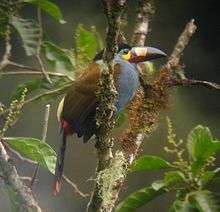Plate-billed mountain toucan
| Plate-billed mountain toucan | |
|---|---|
 | |
| In northwestern Ecuador | |
| Scientific classification | |
| Kingdom: | Animalia |
| Phylum: | Chordata |
| Class: | Aves |
| Order: | Piciformes |
| Family: | Ramphastidae |
| Genus: | Andigena |
| Species: | A. laminirostris |
| Binomial name | |
| Aulacorhynchus laminirostris Gould, 1851 | |
The plate-billed mountain toucan (Andigena laminirostris) is a species of bird in the family Ramphastidae. It is native to Colombia and Ecuador, where it lives in the high-altitude humid montane forests of the Andes. It is also known as the laminated hill-toucan, laminated mountain-toucan, and plain-billed mountain-toucan.
Description
Two different colorations of the species can be found. The northern birds have a brown iris and half its maxilla of an orange color. Southern birds have their iris violet/green with their maxilar being divided into pink and yellow with a black base surrounded with a blush line. The head is relatively large with a cervical band of a grayish blue color and the upper part a brownish green, green wings, grayish blue rump with red crissum (the undertail coverts surrounding the cloaca) and brownish thighs.
The upper parts and wings are golden olive in color and the underparts are bright blue with yellow lateral patches. The crown and nape are black, the rump is bright yellow, and the thighs are reddish brown. The tail feathers are gray with dark green and red coverts. The face has patches of yellow and yellow-green and the iris is red. The bill is black with areas of red and ivory.
 |
|
| Problems playing this file? See media help. | |
The plate-billed mountain toucan is about 42 to 53 centimeters (16.5 to 21 inches) in length, with a relatively lightweight bill up to 10 centimeters long. The average male weighs about 314 grams (11.1 ounces) and the female about 303 grams (10.7 ounces). It is zygodactylous, with two toes facing forward and two pointing back.
Vocalizations
This is the most vocal of the mountain toucans, and the sexes often duet. The male makes a loud, repeating "tryyyyyyyk" sound and the female makes a drier "t't't't't't't't" noise. The bird utters rattles and clicks loud enough to be heard from over a kilometer away.
Distribution and habitat
Plate-billed mountain toucans are found in the western foothills of the Andes of western Ecuador and far southwestern Colombia. In Colombia, they are found from Pita Canyon (Narino) in southwestern Colombia and south to the northwestern border of Morona-Santiago Province, in Ecuador. Plate-billed mountain toucans inhabit the humid forest and edges of the temperate forest of the lateral slope of the Andes Mountains. The humid forest features abundant epiphytes, bromeliads and mosses. These forests receive an average of 14 feet of rainfall per year and the canopy ranges from 6 to 10 meters high. Their altitudinal range is between 1600 and 2600 meters above sea level, and has been observed several times at 3100 meters elevation in Imbabura (Ecuador). Because of its altitudinal range, plate-billed mountain toucans share their ecological niche with the Andean cock-of-the-rock. Their estimated life area is 14300 km2.
Behaviour and ecology
Breeding
The breeding season extends from March to October, peaking in May through August. The bird nests in tree cavities up to 30 meters above the ground. The clutch contains 2 or 3 white eggs. The eggs are incubated for about 16 days and the young fledge at 46 to 60 days. Once the young depart, the pair may rear a second brood.
Food and feeding
The plate-billed mountain toucan feeds mainly on fruit, and occasionally eats insects and eggs as well. It disperses the seeds of plants such as the mountain understory shrub Faramea affinis[2] and the palm Prestoea acuminata.[3] There has been a report of the bird eating a caecilian (Caecilia sp.)[4]
Status
While is still a fairly common species, the Plate-billed mountain toucan is considered Near Threatened by the IUCN and is in decline because of habitat being lost to deforestation. It is also poached for the trade in exotic birds.[1] The plate-billed mountain toucan is the flagship bird of the La Planada Nature Reserve in Colombia.[5]
References
- 1 2 BirdLife International (2012). "Andigena laminirostris". IUCN Red List of Threatened Species. Version 2013.2. International Union for Conservation of Nature. Retrieved 26 November 2013.
- ↑ Restrepo, C. and A. Vargas. (1999). Seeds and seedlings of two neotropical montane understory shrubs respond differently to anthropogenic edges and treefall gaps. Oecologia 119(3) 419-26.
- ↑ Gamba-Trimiño, C., et al. (2011). Demography of the clonal palm Prestoea acuminata in the Colombian Andes: sustainable household extraction of palm hearts. Tropical Conservation Science 4(4) 386-404.
- ↑ Solano-Ugalde, A. (2011). The Plate-billed Mountain Toucan (Andigena laminirostris) feeding on a Caecilia spp (Gymnophiona: Amphibia). Boletín SAO 20(2) 43-5.
- ↑ Vallejo, M. I., et al. (2004). La Planada forest dynamics plot, Colombia. Tropical Forest Diversity and Dynamism: Findings from a large scale plot network.
References
BirdLife International (2008). «'Andigena laminirostris'». Lista Roja de especies amenazadas de la UICN 2010.4 (en inglés). Consultado el 19 de noviembre de 2010
External links
| Wikimedia Commons has media related to Andigena laminirostris. |
- Andigena. ITIS
- Plate-billed Mountain-toucan, Andigena laminirostris. BirdLife International.
